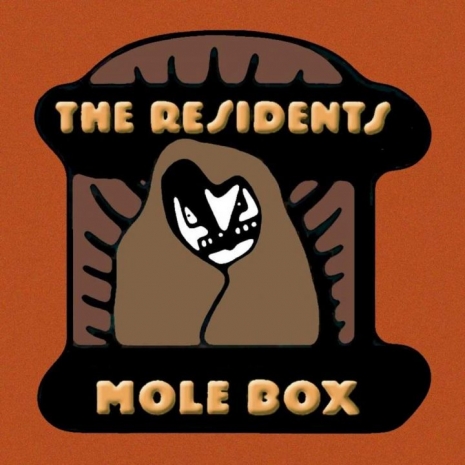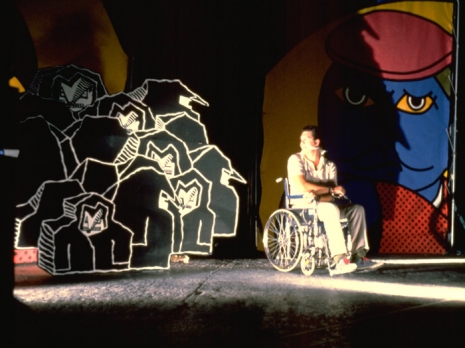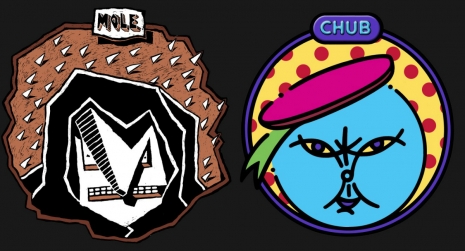
The Residents’ ‘Mole Box,’ new from Cherry Red
We had to borrow money from our parents to get us this show! It takes, it takes three weeks for a check from Louisiana to clear the banks! All he wanted to know was, who were—who were the Chubs and who were the Moles? It—it—it seemed like an easy question. I mean, we were the Moles, that was real obvious, we figured that—just like that, we figured that out immediately.
—The Mole Show Live at the Roxy, 1982
The Mole Show—a stage production based on the Residents’ ambitious Mole Trilogy project, a kind of science fiction epic about labor, race and rock music inspired by The Grapes of Wrath—was the first show the group took on the road. Dramatizing the conflict between the ugly and industrious Moles and the cute, suburban Chubs, it was emceed by Penn Jillette, whose role was to make the audience want to kill him. He would begin by insulting the band (“Rather flashy, in a low-tech sort of way”) and come unglued as the show went on, culminating in a total meltdown between “The New Machine” and “Song of the Wild”; long after his mike had been cut, he’d be dragged offstage screaming “THIS IS A FUCKING RIPOFF! THE RESIDENTS ARE TAKING YOU FOR A GODDAMN RIDE!” Jillette would reappear onstage for “Satisfaction,” but Groucho-glassed, gagged and handcuffed to a wheelchair—”a castrated clown in the seat of a cynic.”
The show’s success in Europe did not save it from becoming, in the words of band biographer Ian Shirley, a “financial disaster.” As the Beach Boys abandoned Smile, the Residents left the Mole Trilogy unfinished, at an incalculable cost to American culture.

Penn gagged and handcuffed (via residents.com)
Audiences at the Residents’ first tour would see the band members as silhouettes performing behind a burlap scrim, while stagehands and dancers in Groucho glasses manipulated the props and scenery illustrating the first part of the saga, concerning the Moles’ exodus and subsequent conflict with the Chubs. Painted canvas backdrops represented the alien landscapes of these beings’ all-too-familiar worlds; years later, as if to exorcise the memory the show, the Residents cut the backdrops into strips and sent them out with Ralph orders, which explains the piece of the Mole Show set I have in my closet.

The Residents behind the scrim (via residents.com)
Even with the show scripted to fall apart, everything went wrong. Penn Jillette’s appendix exploded in Madrid shortly before the band performed on the TV show La Edad de Oro, and the tour’s stage manager took on the emcee’s role, antagonizing the audience and mocking the show. Uncle Willie’s official Residents guide explains how this Brechtian element of the performance was supposed to function:
The Mole Show was conceived to tell a fable about a culture that is forced to co-exist with a different culture, and, naturally, the inevitable “anger, confusion, and frustration” inherent to the situation. But, The Residents knew that just telling an audience about this would never do. They scripted the show so that a major character would “rebel” against the performance. In an illusion of “breaking the proscenium,” he would express his “anger, confusion and frustration” over his role in the show thereby bringing the whole performance to an awkward and disturbing end. The audience would leave confused as to what was real and what was not. The Residents were successful. Audiences left the theaters in Europe and the USA feeling just as The Residents expected, “angry, confused and frustrated.”

via residents.com
Anger, confusion and frustration haunted the Mole Show. Two members of the four-man Cryptic Corporation, Jay Clem and John Kennedy, had quit just as the Mole Show was getting off the ground, contributing to the parlous state of the Residents’ finances. Ian Shirley writes that the tour ended in a deep hole of debt, with the band’s gear confiscated by an English shipping company and the members swearing off touring forever on the flight home. In order to mount the show one last time at the New Music Festival in Washington, D.C. in October ‘83, a gig the band took to pacify its creditors, the Residents had to cobble together an approximation of their live setup and rebuild all the sets and props from scratch. (This was the storied last performance of the production included in this set: the “Uncle Sam Mole Show,” all of it previously unreleased except “Happy Home/Star Spangled Banner.”)

via residents.com
These disasters probably explain why the Residents never finished the series. The group had envisioned the Mole Trilogy in six parts, “a trilogy of pairs”:
Initially the project was designed to be a collection of six albums: three of the LPs were intended to tell an epic story, connecting several generations of two fictitious races, while the three additional albums were designed to serve as musical “illustrations” for this story. It was to be a trilogy of pairs, with each contributing both to the narrative and cultural context of the ongoing saga.
The first pair of albums, Mark of the Mole (1981) and The Tunes of Two Cities (1982), followed this scheme: Mark told the beginning of the narrative, while Tunes presented ethnomusicological artifacts of the Chub and Mole cultures. While releases bearing the disclaimer “THIS IS NOT PART THREE OF THE MOLE TRILOGY” proliferated—Intermission, The White Single, Residue of the Residents, George & James—Part Three never appeared. But its complement, Part Four, did: an album by the Big Bubble, a group that sings in the outlawed language of the Moles. Their big break comes at a rally for the nationalist Zinkenite movement, which celebrates the Moles’ traditional culture, even though most of its members are products of mixed Mole-Chub marriages. This, presumably, was to have been the story told by Part Three of the Mole Trilogy.

Black Shroud recording artists the Big Bubble, from Part Four of the Mole Trilogy, ‘The Big Bubble’
Mole Box, the latest in the Residents’ pREServed series of expanded reissues, collects all the surviving pieces of the Mole Trilogy. This means all the canonical Mole releases: the studio albums Mark of the Mole, The Tunes of Two Cities, and The Big Bubble, along with the excellent Intermission EP, a collection of “extraneous music” from the Mole Show. Each of the albums is supplemented with outtakes, demos, live recordings, or other material from the Residents’ vaults.
The Residents Present the Mole Show Live in Holland is the record of the tour already in circulation. Here, in its place, we get recordings from the beginning and end of the tour, with an October ‘82 performance at LA’s Roxy on one disc and the final “Uncle Sam Mole Show,” recorded a year later, on another.
The final disc is the real treasure. Early instrumental mixes of the Mark of the Mole sessions are quite beautiful (“The New Machine”!); they’re represented by the Residents’ new 25-minute edit, “MOTM Mix One Concentrate.” Among much other material of interest on this disc (including all of Intermission) are two never-before-heard tracks likely to have come—the Residents won’t say for sure—from Part Three of the Mole Trilogy, “Going Nowhere” and “Now It Is Too Late.” A third track, “Marching to the We,” taken from the download-only Mole Suite, seems to provide another glimpse of the abandoned LP.
Do you realize what this means? It means that, for all the world’s problems in 2019, at least the Residents fan can, at long last, stand tall, clutching a copy of the Mole Box, and proclaim, in good conscience: “THIS MIGHT BE PART OF PART THREE OF THE MOLE TRILOGY!”
Mole Box comes out today, April 5, on Cherry Red Records. Below, Penn Jillette and the Residents appear in a feature about the Mole Show on the BBC’s Riverside.
Previously on Dangerous Minds:
‘Oh Mummy! Oh Daddy!’ The Residents’ first show as The Residents, 1976
The Residents’ press conference at the Lincoln Memorial, 1983
RIP Hardy Fox, ‘primary composer’ and ‘co-founder’ of the Residents